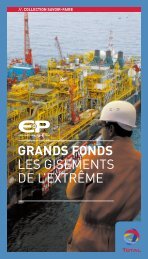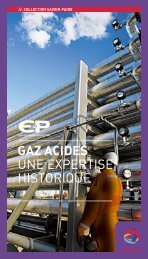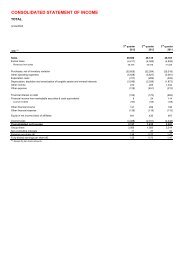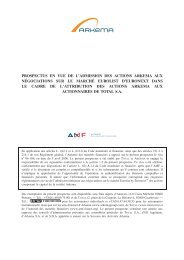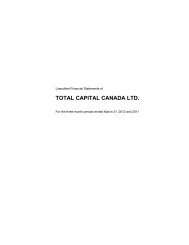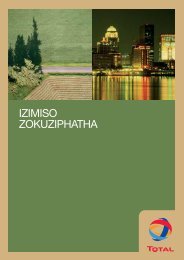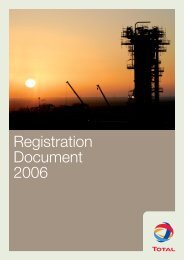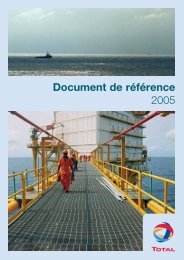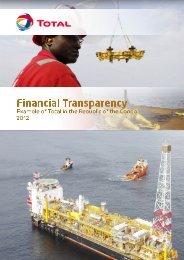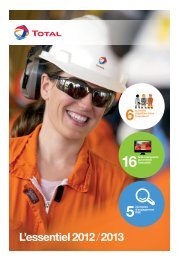Registration Document 2005 - Total.com
Registration Document 2005 - Total.com
Registration Document 2005 - Total.com
You also want an ePaper? Increase the reach of your titles
YUMPU automatically turns print PDFs into web optimized ePapers that Google loves.
Crude oil costs include raw material and receipt costs. Refining<br />
costs principally include the crude oil costs, production costs<br />
(energy, labor, depreciation of producing assets) and allocation of<br />
production overhead (taxes, maintenance, insurance, etc). Start-up<br />
costs and general administrative costs are excluded from the cost<br />
price of refined products.<br />
Chemicals<br />
Costs of chemical products inventories consist of raw material<br />
costs, direct labor costs and an allocation of production overhead.<br />
Start-up costs and general administrative costs are excluded from<br />
the cost of inventories of chemicals products.<br />
N. Treasury shares<br />
Treasury shares of the parent <strong>com</strong>pany TOTAL S.A. held by its<br />
subsidiaries or itself, are deducted from consolidated shareholders’<br />
equity. Gains or losses on sales of treasury shares are excluded<br />
from the determination of net in<strong>com</strong>e and are recognized in<br />
shareholders’ equity.<br />
O. Other non-current liabilities<br />
Non-current liabilities <strong>com</strong>prise liabilities for which the amount and<br />
the timing are uncertain. They arise from environmental risks, legal<br />
and tax risks, litigation and other risks.<br />
A provision is recognized when the Group has a present obligation<br />
(legal or constructive) as a result of a past event for which it is<br />
probable that an outflow of resources will be required and when a<br />
reliable estimate can be made of the amount of the obligation. The<br />
amount of the liability corresponds to the best possible estimate.<br />
P. Asset retirement obligations<br />
Asset retirement obligations, which result from a legal or<br />
constructive obligation, are recognized on the basis of a reasonable<br />
estimate of their fair value in the period in which the obligation<br />
arises.<br />
The associated asset retirement costs are capitalized as part of the<br />
carrying amount of the long-lived assets and depreciated over the<br />
useful life of the associated long-lived asset.<br />
An entity is required to measure changes in the liability for an asset<br />
retirement obligation due to the passage of time (accretion) by<br />
applying a discount rate that reflects the time value of money to the<br />
amount of the liability at the beginning of the period. The increase<br />
of the provision due to the passage of time is recognized as “Other<br />
financial expense”.<br />
Appendix 1 – Consolidated financial statements<br />
Notes to the consolidated financial statements 9<br />
Q. Employee benefits<br />
In accordance with the laws and practices of each country, the<br />
Group participates in employee benefit plans offering retirement,<br />
death and disability, healthcare and special termination benefits.<br />
These plans provide benefits based on various factors such<br />
as length of service, salaries, and contributions made to the<br />
governmental bodies responsible for the payment of benefits.<br />
These plans can be either defined contribution or defined benefit<br />
pension plans and may be entirely or partially funded with<br />
investments made in various non-Group instruments such as<br />
mutual funds, insurance contracts, and others.<br />
For defined contribution plans, expenses correspond to the<br />
contributions paid.<br />
Defined benefits obligations are determined according to the<br />
Projected Unit Method. Actuarial gains and losses may arise from<br />
differences between actuarial valuation and projected <strong>com</strong>mitments<br />
(depending on new calculations or assumptions) and between<br />
projected and actual return of plan assets.<br />
The Group applies the corridor method to amortize its actuarial<br />
gains and losses. This method amortizes the net cumulative<br />
actuarial gains and losses that exceed 10% of the greater of the<br />
present value of the defined benefit obligation and the fair value<br />
of plan assets, over the average expected remaining working lives<br />
of the employees participating in the plan.<br />
In case of a change in or creation of a plan, the vested portion of<br />
the cost of past services is recorded immediately in the in<strong>com</strong>e<br />
statement, and the unvested past service cost is amortized over<br />
the vesting period.<br />
The net periodic pension cost is recognized under “Other operating<br />
expenses”.<br />
R. Consolidated statement of cash flows<br />
The consolidated statement of cash flows prepared in foreign<br />
currencies have been translated into euros using the average<br />
exchange rate of the period. Currency translation differences<br />
arising from the translation of assets and liabilities denominated in<br />
foreign currency into euros using exchange rates at the end of the<br />
period are shown in the balance sheet under “Effect of exchange<br />
rates and changes in reporting entity”. Therefore, the consolidated<br />
statement of cash flows will not agree with the figures derived from<br />
the consolidated balance sheet.<br />
Cash and cash equivalents<br />
Cash and cash equivalents are highly liquid investments that are<br />
readily convertible into cash and have original maturities of three<br />
months or less. Changes in bank overdrafts are included in cash<br />
provided by financing activities.<br />
TOTAL - <strong>Registration</strong> <strong>Document</strong> <strong>2005</strong><br />
175




